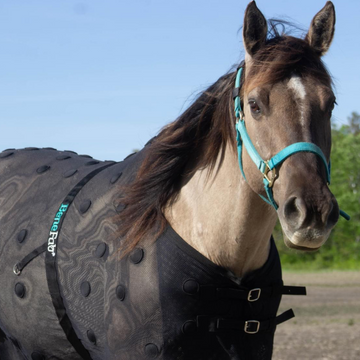 matter how easily or not they tend to gain weight. Equine Obesity is defined when there is excess of body fat which has accumulated to the extent that it may have an opposing effect on the health of your equine companion. Miniature horses and ponies are more prone to obesity due to their naturally smaller body mass. Unfortunately, this can be to the fault of the owner as most owners of large breed horses tend to overfeed smaller ponies and/or miniatures. Obese ponies are not cute!
There is a scale used to measure the overall appearance and fitness level of a horse – this is known as a ‘condition score’. Scores are measured from one to nine. One being emaciated and nine being obese. Ideally, you want your horse to be around a 5-7, depending on their job. A horse that is a five should have a flat back and its shoulders and neck fade into the body smoothly and the horse’s ribs are not easily noticeable. It is a good idea to use a weight tape weekly (measured around the horse’s girth). Record the weight so that the diet can be adjusted accordingly. If your horse is losing weight drastically or vice versa, you may be able to consult a Veterinarian and present them with hard data so that they may be able to more efficiently diagnose the issue. For example: a horse losing weight drastically may be suffering from Ulcers; a horse gaining weight drastically may be suffering from a metabolic issue. Below are great condition score and topline evaluation charts (curtesy of Nutrena®) that I received from a continuing education conference that I attended >>>
Equine Body Condition Score
Topline Evaluation Form
Obese horses are more prone to laminitis and chronic founder, most likely due to abnormal glucose metabolism. Overweight animals can become resistant to the actions of insulin, resulting in higher levels of insulin being secreted when the horse eats a meal. These high levels of insulin may lead to increased incidents of laminitis and founder (often referred to as equine metabolic syndromes). The added weight of the horse may also make the rotation of the coffin bone worse than what would result in a horse of an appropriate weight.
Causes of obesity:
matter how easily or not they tend to gain weight. Equine Obesity is defined when there is excess of body fat which has accumulated to the extent that it may have an opposing effect on the health of your equine companion. Miniature horses and ponies are more prone to obesity due to their naturally smaller body mass. Unfortunately, this can be to the fault of the owner as most owners of large breed horses tend to overfeed smaller ponies and/or miniatures. Obese ponies are not cute!
There is a scale used to measure the overall appearance and fitness level of a horse – this is known as a ‘condition score’. Scores are measured from one to nine. One being emaciated and nine being obese. Ideally, you want your horse to be around a 5-7, depending on their job. A horse that is a five should have a flat back and its shoulders and neck fade into the body smoothly and the horse’s ribs are not easily noticeable. It is a good idea to use a weight tape weekly (measured around the horse’s girth). Record the weight so that the diet can be adjusted accordingly. If your horse is losing weight drastically or vice versa, you may be able to consult a Veterinarian and present them with hard data so that they may be able to more efficiently diagnose the issue. For example: a horse losing weight drastically may be suffering from Ulcers; a horse gaining weight drastically may be suffering from a metabolic issue. Below are great condition score and topline evaluation charts (curtesy of Nutrena®) that I received from a continuing education conference that I attended >>>
Equine Body Condition Score
Topline Evaluation Form
Obese horses are more prone to laminitis and chronic founder, most likely due to abnormal glucose metabolism. Overweight animals can become resistant to the actions of insulin, resulting in higher levels of insulin being secreted when the horse eats a meal. These high levels of insulin may lead to increased incidents of laminitis and founder (often referred to as equine metabolic syndromes). The added weight of the horse may also make the rotation of the coffin bone worse than what would result in a horse of an appropriate weight.
Causes of obesity:
1. Overfeeding – frequently involving the overfeeding of inactive horses 2. Untreated intestinal parasites can contribute to obesity 3. Too much pasture forage (forage can be higher in calorie content than some feeds) 4. Not enough exercise 5. Age-related increases of inflammation
Exercise and increasing physical activity Appropriate exercise is essential for all horses, but levels of activity must increase gradually without stressing an unfit horse. For a sound and otherwise healthy horse, exercise is one of the best means of assisting weight loss and improving physical health and fitness. Regular exercise should form an active part of the weight loss program. A horse can be exercised in hand, ridden or loose (i.e. freestyle) – to properly exercise a horse loosely, we recommend challenging them in ways beyond doing what they would naturally do in a pasture. Whether riding, working in hand or loosely, challenge the horse to change directions frequently, exercise transitions (upward and downward), practice adjusting their stride length and teach proper lateral movement in both directions. Exercising a horse daily in two shorter sessions rather than one long session helps increase the benefits without straining the animal and maintains interest and variety throughout the day. <<< Those of you who work with youngsters, this is a great tip to building strength while keeping their focus. Once a horse has returned to a good, healthy condition, it is essential to take actions to ensure that the desired weight and condition are maintained so weight gain is avoided. Adopt a sensible management regime that ensures a horse has a suitable, balanced diet with plenty of appropriate exercise. Benefab® by Sore No-More® offers a variety of products for pre- and post- exercise. One of our most popular products is our Rejuvenate SmartScrim – this is a wonderful pre- and post- exercise product to use. The ceramic-infused fabric emits far-infrared rays keeping back muscles warm and relaxed which can be very beneficial in reducing risk of injury pre-ride as well as decreasing overall warmup time. It also features 80 medical grade magnets which have been sewn over pre-determined acupuncture points for a targeted therapy in key areas such as the vertebrae, shoulders, hips and hind gut. It doubles as a fly sheet or therapeutic scrim and can be left on for up to 12 hours in just about any climate. Ultimately, the SmartScrim helps harmonize bodily functions safely and naturally, stimulating recovery time, promoting blood circulation, increasing oxygen flow, and reducing pain and/or stiffness.




















